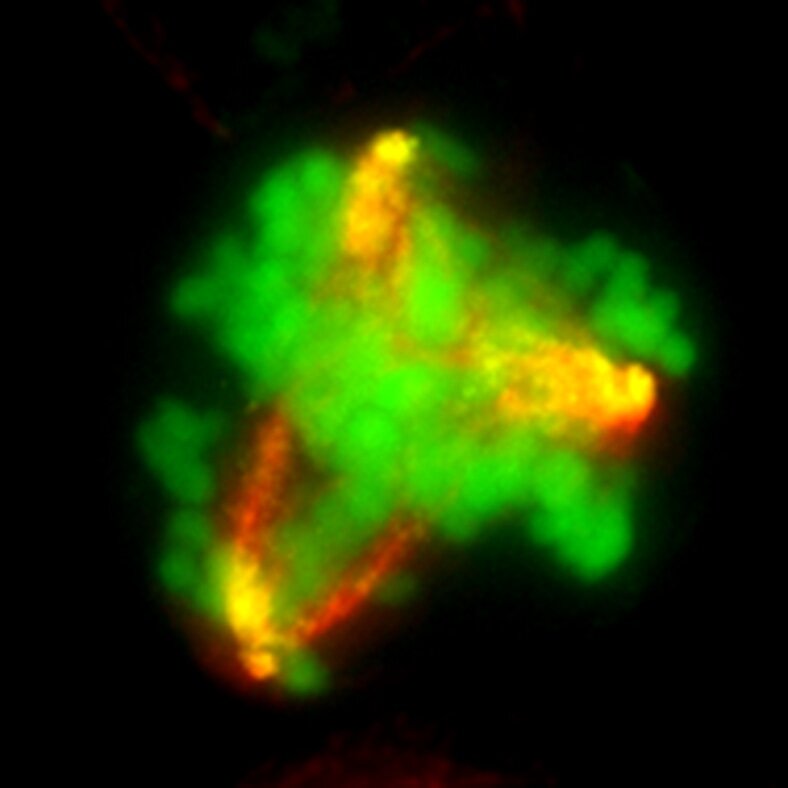
Image of a triple-negative breast cancer cell in abnormal division after KIF18A inhibition (red = microtubules; green = chromosomes; yellow = spindle poles). Credit: Cindy Fonseca, MS, Stumpff Lab, UVM Larner College of Medicine
Unraveling the unique characteristics of cancer cells and finding less harmful ways to stop their growth has been the focus of cancer researchers around the world. New discoveries, reported in Nature Communications, describe the discovery of a unique dependence of cancer cells on a specific protein, which can lead to the desperately needed treatment for cancers that are difficult to treat.
The publication closes a series of innovative studies that appear in Nature journals in the last month by members of a powerful international research collaboration.
Lead author and researcher at the University of Vermont Cancer Center (UVM) Jason Stumpff, Ph.D., has spent more than two decades studying how cells divide and how errors in this process contribute to diseases such as cancer. Their recent work has increased their understanding of the role of a protein called KIF18A in driving cell division. In these new studies, Stumpff’s laboratory demonstrates that cancer cells, with the type of abnormalities seen in aggressive tumors, are more dependent on KIF18A for growth than normal cells. This vulnerability in cancer cells could be a potential target to halt the growth of cancer cells, as the researchers demonstrated in triple negative breast cancer and colorectal cancer cells.
These findings mark a milestone in a long research journey that began with the support of an American Cancer Society Institutional Research Grant pilot award through the University of Vermont Cancer Center and then led to Susan G. Komen and funding from the National Institutes of Health (NIH). Stumpff, an associate professor of molecular physiology and biophysics at UVM’s Larner College of Medicine, decided to publish his team’s findings early, through an open access preprint. This led to an international collaboration with teams from Tel Aviv University in Israel and the Boston University School of Medicine. Each team was investigating genes necessary for the growth of tumor cells containing abnormal numbers of chromosomes (the wire-like structures that carry a cell’s genetic information) to identify new therapeutic targets.
Stumpff specializes in the mechanical control of cell division and the aspects of this process that contribute to the development of diseases such as cancer. His colleagues at Tel Aviv University were studying aneuploidy – which occurs when one or more chromosomes are added or deleted after cell division – and Boston University partners were focused on duplicating the entire genome, where a complete duplicate set of chromosomes is found in a daughter cell after division.
The role of KIF18A proved to be important in the work of each team and contributed to a broader and clearer picture of its role and importance in stopping the growth of abnormal tumor cells. Critical to the series of group discoveries was the early sharing of knowledge and unpublished data, as well as the collective resolution of issues and verification of results. Their efforts have produced solid results – three publications Nature and Nature Communications reporting revolutionary discoveries that could contribute to more targeted and less harmful drug treatments for some cancers.
A confluence of data shared openly, involving clinical experts and cancer patients and taking advantage of a collaborative approach were key components of the success of this research, notes Stumpff.
“The collective impact of this research collaboration exemplifies the importance of sharing data and increasing the rigor of scientific studies to effectively move the discovery of fundamental science towards important progress in the fight against cancer,” said Stumpff. “This work has the potential to improve approaches to treating patients in the future – and we look forward to keeping you moving.”
A new study reveals the vulnerability of cancer cells
Nature Communications (2021). DOI: 10.1038 / s41467-021-21447-2
Provided by Larner College of Medicine at the University of Vermont
Quote: The vulnerability of cancer cells points to a potential treatment path for aggressive diseases (2021, February 22) recovered on February 23, 2021 at https://medicalxpress.com/news/2021-02-cancer-cell-vulnerability -potential-treatment.html
This document is subject to copyright. In addition to any fair dealing for the purpose of study or private research, no part may be reproduced without written permission. The content is provided for informational purposes only.
